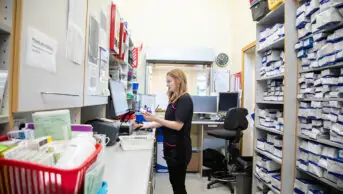
Wes Mountain/The Pharmaceutical Journal
In May 2024, the Department of Health and Social Care (DHSC) ended a two-year wait for the outcome of its 2022 consultation on hub-and-spoke dispensing. The outcome confirmed the government’s plans to progress changes to legislation that will allow different companies to band together to set up hub-and-spoke dispensing partnerships — effectively outsourcing dispensing to a third party. Current legislation does not permit this, instead reserving the hub-and-spoke model for single companies, largely multiples that already have many ‘spokes’.
Hub-and-spoke dispensing used to be a highly controversial topic. The DHSC’s previous consultation on similar proposals in 2016 was met with several concerns. The Pharmaceutical Services Negotiating Committee, now Community Pharmacy England (CPE), said at the time that it “vigorously opposed” the proposals owing to concerns around “professional and legal implications” that could lead to patient safety issues. The Royal Pharmaceutical Society (RPS) also said it had “reservations around patient care and safety” within the dispensing model.
Ultimately, the DHSC parked its proposals, on the basis of the responses to the consultation.
Since then — and particularly since the ‘Community pharmacy contractual framework‘ was published in July 2019 — opinions have softened. The framework froze funding for five years and outlined plans for community pharmacies to earn their money by offering more clinical services to patients, reducing time spent on dispensing “as new technology and transformation is enabled”.
The result of delaying changes to hub-and-spoke legislation is an overstretched workforce, with 86% of pharmacists at high risk of burnout
A DHSC impact assessment for the five-year contract, obtained by The Pharmaceutical Journal through a freedom of information request to the DHSC in 2020, described hub-and-spoke as “a key component of delivering a transformation programme to release pharmacist time from dispensing”. The impact assessment added that the government estimated the efficiency benefits brought about by hub-and-spoke “will serve to offset some of the costs of delivering the new services”.
The model’s implementation seemed a foregone conclusion if community pharmacy’s aspirations of offering more clinical services were to be realised.
This was reflected in responses from pharmacy bodies to the consultation in 2022, with the RPS’s response stating that it broadly agreed with the new proposals, although some patient safety concerns remain. CPE said in its response that it changed it position “primarily due to assurances from the DHSC that it will agree with [CPE] which models will allow the whole sector to benefit fairly”.
However, between Brexit and the COVID-19 pandemic, other government priorities delayed changes to hub-and-spoke legislation, while the clinical services have been implemented anyway. The result is an overstretched workforce, with 86% of pharmacists at high risk of burnout, according to the RPS’s 2024 ‘Workforce wellbeing survey‘. The underlying factors contributing to this include inadequate staffing, lack of work–life balance and long working hours.
In an opinion piece, published exclusively in The Pharmaceutical Journal, after the DHSC’s consultation outcome was published on 13 May 2024, pharmacy minister Andrea Leadsom said: “I know there are challenges facing pharmacies that go beyond the dispensing of medicines, but this change could have a significant impact on busy community pharmacies and deliver real benefits to patients in need of pharmacy’s help and expertise.”
The impact, however, may be overstated. A second impact assessment drawn up by the government that focuses on its hub-and-spoke proposals estimates that a pharmacy will be able to have around 40% of its prescription items dispensed through a hub, but adds that only 38% of pharmacies would actually benefit from the new legislation giving them access to a hub in the first place. The rest either dispense too few items to make the investment of a hub-and-spoke set up worthwhile or are part of a multiple that can already dispense from a central hub under current legislation.
Of that 38%, the assessment says it expects only “12% of potential beneficiaries would adopt hub-and-spoke [dispensing] within the next five years, while a further 20% would adopt over the next ten years,” its modelling being based on private market research. As a result, in the tenth year after the new hub-and-spoke legislation is implemented, only 7% of items (75 million items) dispensed would go through a hub, the assessment says.
If the policy objective “is to support all pharmacies to improve the efficiency of their dispensing through the option of entering into hub-and-spoke dispensing arrangements with other pharmacy businesses,” as the impact assessment states, then these proportions and timescales are disconcerting.
The changes are now too little, too late — the focus must turn to agreeing a new contractual framework
Far from being a “key component” to the transformation of pharmacy services, changing legislation around hub-and-spoke threatens to make no difference to “the challenges facing pharmacies” at all.
LloydsPharmacy, once one of the largest multiple pharmacies in the UK, was an early adopter of the hub-and-spoke model. Yet in 2023, the company exited the pharmacy market, owing to “changing market conditions”. At the time, the Company Chemists Association said that the loss of LloydsPharmacy should be “a wake-up call to the government” regarding the deteriorating community pharmacy sector.
Pharmacies of all sizes have buckled under pressure in the nine years since the DHSC first floated changes to hub-and-spoke legislation. The changes are now too little, too late. Instead, the focus must turn to agreeing a new contractual framework — to replace the five-year contract that expired at the end of March 2024 — offering a generous funding package to benefit more than just a minute proportion of the community pharmacy sector. PJ


